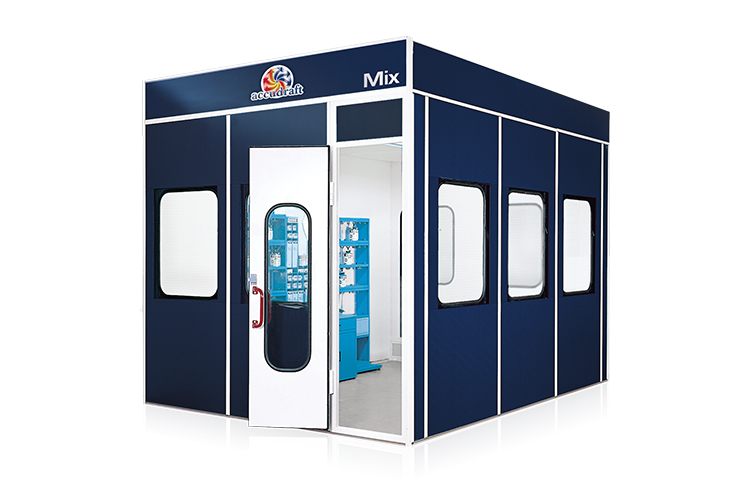If painting in your facility or shop is a regular occurrence or standard production, yes you should have a paint mix room at the very least. This is the bare minimum as mixing paint and storing tools used to mix and cleaners etc. creates a potentially hazardous situation in any building. The only other thing you may consider is a paint storage room that is designed for containment and housing paint and related materials. A paint mixing room gives your shop a safe and ventilated place to keep some of the most volatile products used in the painting process. The mix room is supposed to be ventilated ALL THE TIME so don’t turn the fan off at night!

Paint mixing rooms are important pieces of equipment for a variety of reasons. In most cases, auto collision shops or any type of finishing facility that employs a spray area, spray room, or paint booth should also include the use of a paint mixing room in their painting process and include it in their building layout.
Paint mixing rooms provide a clean and safe environment for workers to store and mix their coatings. Harmful fumes are exhausted from the space an fresh air is introduced via powered fans. The area is also kept clean and exposure to contaminants like dust and particles from the shop is minimized.
General Rule: If our are storing and mixing paint for spray operations, it is recommended that you install a paint mixing room. Paint mixing rooms are most often required by code in order to safely store and ventilate the flammable liquids contained in a finishing shop or facility.
Once a paint mixing room is installed and is part of spray operations, there are limitations to the total amount of paint or flammable liquids that can be stored or be present between the spray area and the mix room. If the mix room is within 6 feet of the spray area, the amount of flammable liquids allowed is approximately 120 gallons. If the mix room is more than 6 feet away from the spray area, the total allowed goes up to 360 gallons.
Some of the major codes that apply to mixing rooms and spray booth operations are dictated by the NFPA (National Fire Protection Association). Other codes also apply and some may definitely be unique to your specific installation and where the paint mixing room is located within the building, but the NFPA’s requirements and limitations regarding paint mixing rooms should give you the best general idea of why paint mixing rooms exist and whether you need a paint mixing room in your body shop or finishing facility.
Below are the standards per NFPA on what a mixing room is designed to do and how it should operate in order to meet code. Other codes may apply and there are references to other chapters. You can purchase a full version of code books at nfpa.org.
( 1) The mixing room shall meet the construction requirements
of Section 5.1. – Section 5.1 basically breaks down the construction of the paint mixing room. They are required to be built much like a spray booth. Non combustible materials with regulation on the types and thicknesses of materials etc. Any paint booth manufacturer should have this type of construction built in right out of the box.
(2) The area of the mixing room shall not exceed 14 m2
(150 ft2).
(3) The mixing room shall be designed to contain a spill of
the contents in the room.
(4) The mixing room used for mixing and dispensing operations shall be provided with continuous mechanical ventilation at a particular rate per the size of the mix room and the ventilation system shall be in operation at all times.
(5) Mixing rooms shall be classified , for purposes
of electrical area classification, the same as enclosed
spray booths, in accordance with 6.5.4. – Section 6.5.4 dictates the classification of zones in, adjacent to, and outside the mix room for purposes of knowing where electrical fixtures may or may not be placed or whether those fixtures need to be rated for the zone that they will be installed in.
(6) The mixing room shall be provided with an approved automatic
fire protection system that meets all applicable
requirements of Chapter 9. – Chapter 9 discusses fire suppression and many aspects of fire prevention criteria. What is most important to know is that mixing rooms need fire suppression systems just like your paint booth needs one. Many of the same codes apply an it should be handled by the same contractor.
(7) The mixing room shall be provided with portable fire extinguish
located in accordance with NFPA 10, Standard
for Portable Fire Extinguishers. – NFPA 10 discusses the locations for portable fire extinguishers. Your fire suppression contractor should be familiar with this.
Hopefully reading up on some of the reasons for installing a paint mixing room have helped you realize if you need one or not. If you’re currently mixing or storing paint and flammable liquids in your facility without the use of a paint mixing room, please make sure that operations are both safe and clean, if you have any reason to think you are in violation of the codes mentioned above or any other codes, please feel free to comment or contact Accudraft to see if a paint mixing room would be a good idea for your shop.